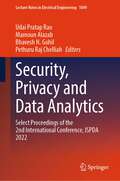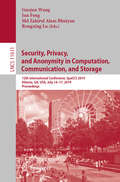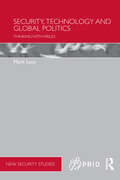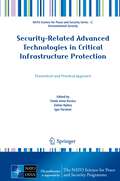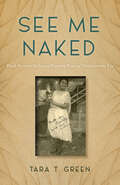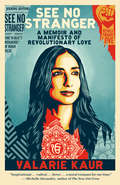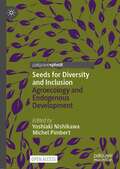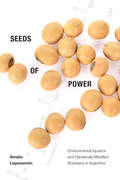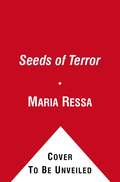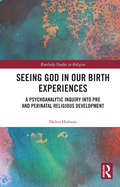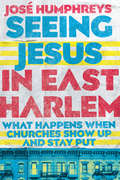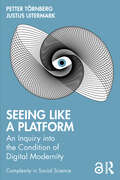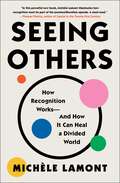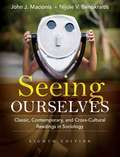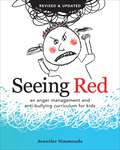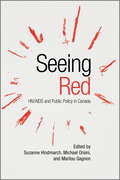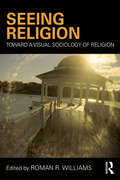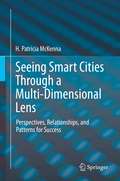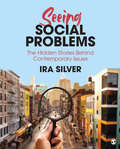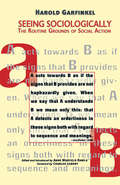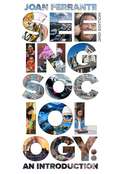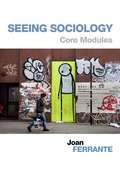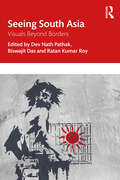- Table View
- List View
Security, Privacy and Data Analytics: Select Proceedings of the 2nd International Conference, ISPDA 2022 (Lecture Notes in Electrical Engineering #1049)
by Pethuru Raj Chelliah Mamoun Alazab Udai Pratap Rao Bhavesh N. GohilThis book constitutes refereed proceedings of the International Conference on Security, Privacy and Data Analytics, ISPDA 2022. The volume covers topics, including big data and analytics, cloud security and privacy, data intelligence, hardware security, network security, blockchain technology and distributed ledger, machine learning for security, and many others. The volume includes novel contributions and the latest developments from researchers across industry and academia working in security, privacy, and data analytics from technological and social perspectives. This book will emerge as a valuable reference for researchers, instructors, students, scientists, engineers, managers, and industry practitioners across the globe.
Security, Privacy, and Anonymity in Computation, Communication, and Storage: 12th International Conference, SpaCCS 2019, Atlanta, GA, USA, July 14–17, 2019, Proceedings (Lecture Notes in Computer Science #11611)
by Rongxing Lu Jun Feng Guojun Wang Md Zakirul Alam BhuiyanThis book constitutes the refereed proceedings of the 12th International Conference on Security, Privacy, and Anonymity in Computation, Communication, and Storage, SpaCCS 2019, held in Atlanta, GA, USA in July 2019. The 37 full papers were carefully reviewed and selected from 109 submissions.The papers cover many dimensions including security algorithms and architectures, privacy-aware policies, regulations and techniques, anonymous computation and communication, encompassing fundamental theoretical approaches, practical experimental projects, and commercial application systems for computation, communication and storage.
Security, Technology and Global Politics: Thinking with Virilio (PRIO New Security Studies)
by Mark LacyThis book analyses some of the key problems explored in Paul Virilio’s theorising on war and security. Paul Virilio has developed a provocative series of writings on how modern societies have shaped the acceleration of military/security technologies – and how technologies of security and acceleration have transformed society, economy and politics. His examination of the connections between geopolitics, war, speed, technology and control are viewed as some of the most challenging and disturbing interventions on the politics of security in the twenty-first century, interventions that help us understand a world that confronts problems that increasingly emerge from the desire to make life safer, faster, networked and more efficient. Security, Technology and Global Politics examines some of the key concepts and concerns in Virilio’s writings on security, society and technology: endo-colonization, fear and the war on terror; cities and panic; cinema and war; ecological security and integral accidents; universities and ideas of progress. Critics often point to an apocalyptic or fatalistic element to Virilio’s writings on global politics, but this book challenges this apocalyptic reading of Virilio’s work, suggesting that – while he doesn’t provide us with easy solutions to the problems we face – the political force in Virilio’s work comes from the questions he leaves us with about speed, security and global politics in times of crisis, terror and fear. This book will be of interest to students of critical security studies, political theory, sociology, political geography, cultural studies and IR in general.
Security-Related Advanced Technologies in Critical Infrastructure Protection: Theoretical and Practical Approach (NATO Science for Peace and Security Series C: Environmental Security)
by Tünde Anna Kovács Zoltán Nyikes Igor FürstnerThis book collects the latest research results on security-related advanced technologies. The chapters contain relevant and interesting topics from numerous research. Data science and artificial intelligence research nowadays one of the most important topics for the industry and the security sectors. The autonomy and counter-autonomy research topic are also very interesting. Autonomous cars have become a part of the common days, but their safe and secure application is not assured. The research results in this field want to support and assure safe and secure autonomous applications in our quotidian life. Also, the safe and secure robotics in the industries and the defence assure a high standard of living and the given research results in this area can use to increase it. The researchers work on it and publish the results that can be interesting for the other researchers and the innovators, but also the industrial part members. The researchers work on it and publish the results that can be interesting for the other researchers and the innovators, but also the industrial part members. Communication is a part of our life, but the communication systems mesh all around the world. Communication is the basis of modern life because without it life stop. One other interesting and very important research area is the material sciences. Virtual life cannot exist without hardware and materials. The new technical applications require new materials, that can suffice the mechanical and physical, chemical properties demand. Nowadays a common requirement of the materials the high strength and lightweight. Researchers want to serve the industrial requests and innovate new composite materials or increase the properties of the material through a new technological process. The authors publish the latest results of the security-related research area including the newest innovations and technologies which rise the interest of the defence and the modern industries even the interest of other researchers.
Seduction of Ethics
by Will C. van den HoonaardFormal research-ethics committees in Canada now function as an industry, costing over thirty-five million dollars annually. The Seduction of Ethics argues that while ethics codes are alluring to the public, they fuel moral panic and increase demands for institutional accountability. Will C. van den Hoonaard explores the research-ethics review process itself by analysing the moral cosmology and practices of ethics committees regarding research and researchers. The Seduction of Ethics also investigates how researchers have tailored their approaches in response to technical demands -- leading social science disciplines to resemble each other more closely and lose the richness of their research. Van den Hoonaard reveals an idiosyncratic and inconsistent world in which researchers employ particular strategies of avoidance or partial or full compliance as they seek approval from ethics committees.
See Me Naked: Black Women Defining Pleasure in the Interwar Era
by Tara T. GreenPleasure refers to the freedom to pursue a desire, deliberately sought in order to satisfy the self. Putting pleasure first is liberating. During their extraordinary lives, Lena Horne, Moms Mabley, Yolande DuBois, and Memphis Minnie enjoyed pleasure as they gave pleasure to both those in their lives and to the public at large. They were Black women who, despite their public profiles, whether through Black society or through the world of entertainment, discovered ways to enjoy pleasure.They left home, undertook careers they loved, and did what they wanted, despite perhaps not meeting the standards for respectability in the interwar era. See Me Naked looks at these women as representative of other Black women of the time, who were watched, criticized, and judged by their families, peers, and, in some cases, the government, yet still managed to enjoy themselves. Among the voyeurs of Black women was Langston Hughes, whose novel Not Without Laughter was clearly a work of fiction inspired by women he observed in public and knew personally, including Black clubwomen, blues performers, and his mother. How did these complicated women wrest loose from the voyeurs to define their own sense of themselves? At very young ages, they found and celebrated aspects of themselves. Using examples from these women’s lives, Green explores their challenges and achievements.
See No Stranger: A Memoir and Manifesto of Revolutionary Love
by Valarie KaurAn urgent manifesto and a dramatic memoir of awakening, this is the story of revolutionary love. &“In a world stricken with fear and turmoil, Valarie Kaur shows us how to summon our deepest wisdom.&”—Elizabeth Gilbert, author of Eat Pray Love How do we love in a time of rage? How do we fix a broken world while not breaking ourselves? Valarie Kaur—renowned Sikh activist, filmmaker, and civil rights lawyer—describes revolutionary love as the call of our time, a radical, joyful practice that extends in three directions: to others, to our opponents, and to ourselves. It enjoins us to see no stranger but instead look at others and say: You are part of me I do not yet know. Starting from that place of wonder, the world begins to change: It is a practice that can transform a relationship, a community, a culture, even a nation. Kaur takes readers through her own riveting journey—as a brown girl growing up in California farmland finding her place in the world; as a young adult galvanized by the murders of Sikhs after 9/11; as a law student fighting injustices in American prisons and on Guantánamo Bay; as an activist working with communities recovering from xenophobic attacks; and as a woman trying to heal from her own experiences with police violence and sexual assault. Drawing from the wisdom of sages, scientists, and activists, Kaur reclaims love as an active, public, and revolutionary force that creates new possibilities for ourselves, our communities, and our world. See No Stranger helps us imagine new ways of being with each other—and with ourselves—so that together we can begin to build the world we want to see.
Seeds for Diversity and Inclusion: Agroecology and Endogenous Development
by Yoshiaki Nishikawa Michel PimbertThis open access book will contribute to a more nuanced debate around seed system resilience that goes beyond the dominant dichotomous conceptualization of seed governance often characterized as traditional vs modern, subsistence vs commercial, or local vs global. While reflecting on the expanding oligopoly in the current seed system, the authors argue that such classifications limit our ability to critically reflect on and acknowledge the diverse approaches through which seed governance is practiced around the world, at various scales, creating a mosaic of dynamic complementarities and autonomies. The authors also highlight the importance of this much needed dialogue through case studies of seed governance approaches and practices found in and around Japan.
Seeds of Power: Environmental Injustice and Genetically Modified Soybeans in Argentina
by Amalia LeguizamónIn 1996 Argentina adopted genetically modified (GM) soybeans as a central part of its national development strategy. Today, Argentina is the third largest global grower and exporter of GM crops. Its soybeans—which have been modified to tolerate being sprayed with herbicides—now cover half of the country's arable land and represent a third of its total exports. While soy has brought about modernization and economic growth, it has also created tremendous social and ecological harm: rural displacement, concentration of landownership, food insecurity, deforestation, violence, and the negative health effects of toxic agrochemical exposure. In Seeds of Power Amalia Leguizamón explores why Argentines largely support GM soy despite the widespread damage it creates. She reveals how agribusiness, the state, and their allies in the media and sciences deploy narratives of economic redistribution, scientific expertise, and national identity as a way to elicit compliance among the country’s most vulnerable rural residents. In this way, Leguizamón demonstrates that GM soy operates as a tool of power to obtain consent, to legitimate injustice, and to quell potential dissent in the face of environmental and social violence.
Seeds of Terror: An Eyewitness Account of Al Qaeda's Newest Center of Operations in Southeast Asia
by Maria RessaFor anyone wishing to understand the next, post-9/11 generation of al-Qaeda planning, leadership, and tactics, there is only one place to begin: Southeast Asia. In fact, such countries as the Philippines, Indonesia, Thailand, and Malaysia have been crucial nodes in the al-Qaeda network since long before the strikes on the Pentagon and World Trade Center, but when the allies overran Afghanistan, the new camps in Southeast Asia became the key training grounds for the future. It is in the Muslim strongholds in the Philippines and Indonesia that the next generation of al-Qaeda can be found. In this powerful, eye-opening work, Maria Ressa casts the most illuminating light ever on this fascinating but little-known "terrorist HQ." Every major al-Qaeda attack since 1993 has had a connection to the Philippines, and Maria Ressa, CNN's lead investigative reporter for Asia and a Filipino-American who has lived in the region since 1986, has broken story after story about them. From the early, failed attempts to assassinate Pope John Paul II and Bill Clinton to the planning of the 9/11 strikes and the "48 Hours of Terror," in which eleven American jetliners were to be blown up over the Pacific, she has interviewed the terrorists, their neighbors and families, and the investigators from six different countries who have tracked them down. After the Bali bombing, al-Qaeda's worst strike since 9/11, which killed more than two hundred, Ressa broke major revelations about how it was planned, why it was a Plan B substitute for an even more ambitious scheme aimed at Singapore, and why the suicide bomber recruited to deliver the explosives almost caused the whole plan to fall apart when he admitted he could barely drive a car. Above all, Ressa has seen how al-Qaeda's tactics are shifting under the pressures of the war on terror. Rather than depending upon its own core membership (estimated at three to four thousand at its peak), the network is now enmeshing itself in local conflicts, co-opting Muslim independence movements wherever they can be found, and helping local "revolutionaries" to fund, plan, and execute sinister attacks against their neighbors and the West. If history is any guide, al-Qaeda revisits its plans over and over until they can succeed -- and many of those plans have already been discovered and are here revealed, thanks to classified investigative documents uncovered by Ressa.
Seeing God in Our Birth Experiences: A Psychoanalytic Inquiry into Pre and Perinatal Religious Development. (Routledge Studies in Religion)
by Helen HolmesThere has been a recent surge in the examination of the evolutionary roots of religious belief, all trying to identify where the human desire to seek the supernatural and the divine comes from. This book adds a new and innovative perspective to this line of thought by being the first to link prenatal and perinatal experiences to the origins of these unconscious underpinnings of our shared images of God. The book poses a ground-breaking paradigm by thinking about our earliest images of God, whether theist or atheist, within a psychoanalytic framework, comparing and contrasting the thought of Freud and Rizzuto. It looks at the issue of images of God from a diversity of psychological perspectives including, attachment theory, developmental theory and bio-psychosocial perspectives. This analysis leads to the conclusion that in parallel to postnatal findings, uterine and birth experiences can predispose individuals to form God representations later in life, through underpinning affective and environmental factors. This is a bold study of the development of one of humanity’s most fundamental aspects. As such, it will be of great interest to scholars of the psychology of religion, psychology, psychoanalysis, religious studies and early infant development.
Seeing Jesus in East Harlem: What Happens When Churches Show Up and Stay Put
by José HumphreysWe are all located in different places. And the way we grow as disciples and lead others in spiritual growth depends on our contexts. Pastor José Humphreys recognizes how deeply our faith is tied to our particular stories in our particular places. Grounded in his own deep faith and wisdom, he writes out of his experiences as a Puerto Rican pastor who has planted a multiethnic church in East Harlem. In this book, he offers a framework to help church leaders take discipleship seriously in their places, calling them to show up, stay put, and see what God is doing in their midst. Combining spiritual formation with activism, vivid narrative with exhortation, and realism with hopefulness, Humphreys offers pastors and church planters a thoughtful look at discipleship in a complex world.
Seeing Like a Platform: An Inquiry into the Condition of Digital Modernity (Complexity in Social Science)
by Petter Törnberg Justus UitermarkPower needs abstraction, to make the unwieldy complexity of the social world legible and manageable. The proposition at the heart of Seeing Like a Platform is that digital technology brings new metaphors through which power operates. While industrial modernity saw society as a machinery to be designed according to detailed blueprints, digital modernity views society as organic and alive, to be herded and nudged through digital infrastructures, AI, and algorithms.Seeing Like a Platform explores the history, meaning, and far-reaching consequences of this epistemological shift. From social movements to Wikipedia, from digital platforms to city planning, from social science to media, society is being redefined by ideas from complexity science. While complexity offers a vision of a self-organized society freed from hierarchies and overbearing bureaucracies, it simultaneously enables new forms of domination and control.Through theoretical reflections and case studies, Seeing Like a Platform offers an inquiry into digital modernity. Accessibly written and broad ranging, it is an essential reading for scholars, students, and practitioners in fields such as sociology, political science, urban studies, and technology studies. It will also interest anyone keen to understand the profound impact of digital technologies on governance, social organization, and everyday life.The Open Access version of this book, available at http://www.taylorfrancis.com, has been made available under a Creative Commons Attribution (CC-BY) 4.0 license.
Seeing Others: How Recognition Works—and How It Can Heal a Divided World
by Michèle LamontAcclaimed Harvard sociologist makes the case for reexamining what we value to prioritize recognition—the quest for respect—in an age that has been defined by growing inequality and the obsolescence of the American dream.In this capstone work, Michèle Lamont unpacks the power of recognition—rendering others as visible and valued—by drawing on nearly forty years of research and new interviews with young adults, and with cultural icons and change agents who intentionally practice recognition—from Nikole Hannah Jones and Cornel West to Michael Schur and Roxane Gay. She shows how new narratives are essential for everyone to feel respect and assert their dignity. Decades of neoliberalism have negatively impacted our sense of self-worth, up and down the income ladder, just as the American dream has become out of reach for most people. By prioritizing material and professional success, we have judged ourselves and others in terms of self-reliance, competition, and diplomas. The foregrounding of these attributes of the upper-middle class in our values system feeds into the marginalization of workers, people of color, LGBTQIA+ individuals, and minority groups. The solution, Lamont argues, is to shift our focus towards what we have in common while actively working to recognize the diverse ways one can live a life. Building on Lamont&’s lifetime of expertise and revelatory connections between broad-ranging issues, Seeing Others delivers realistic sources of hope: By reducing stigma, we put change within reach. Just as Robert Putnam&’s Bowling Alone did for a previous generation, Seeing Others strikes at the heart of our modern struggles and illuminates an inclusive path forward with new ways for understanding our world.
Seeing Ourselves: Classic, Contemporary, and Cross-Cultural Readings in Sociology (Eighth Edition)
by John J. Macionis Nijole V. BenokraitisThis best-selling introductory sociology reader provides classical, contemporary and cross-cultural readings on each key sociological topic. Seeing Ourselves strives to showcase the different perspectives sociology offers and the complexity of the social world. This reader has 72 readings composed of 26 Classic articles, 26 Contemporary articles, and 20 Cross-cultural articles.
Seeing Red: An Anger Management and Anti-Bullying Curriculum for Kids
by Jennifer SimmondsA unique, proven approach to anger management for elementary and middle-school aged children. Anger is a natural human emotion, but if it isn't managed properly its effects can be devastating. Seeing Red is a curriculum designed to help elementary and middle-school aged students better understand their anger so they can make healthy and successful choices and build strong relationships. This completely revised and updated edition includes a comprehensive anti-bullying component, complete with cutting-edge material specific to cyber-bullying and social media.Designed especially for use with small groups, Seeing Red enables participants to learn from and empower one another. Its unique group process helps children and teens build important developmental objectives such as leadership skills (taking initiative, presenting in front of the group), social skills (taking turns, active listening), and building self-esteem (problem solving, interacting with peers). Key concepts and activities include:Spotting anger triggers and taking responsibility for mistakesFinding healthy ways to deal with provocation and avoiding losing controlIdentifying feelings, learning steps to control anger and exploring consequences.Facilitators will learn how to empower participants through role playing, helping them to identify associated feelings and recognize negative behaviors. Each session includes objectives, a list of supplies, background notes and preparation tasks for the leader, a warm-up activity, an explanation of the various learning activities, and a closing activity. See for yourself why Seeing Red remains one of the most highly-regarded resources among professionals in the field of children's anger management.
Seeing Red: HIV/AIDS and Public Policy in Canada
by Suzanne Hindmarch Michael Orsini Marilou GagnonWhat does it mean to think of HIV/AIDS policy in a critical manner? Seeing Red offers the first critical analysis of HIV/AIDS policy in Canada. Featuring the diverse experiences of people living with HIV, this collection highlights various perspectives from academics, activists, and community workers who look ahead to the new and complex challenges associated with HIV/AIDS and Canadian society. In addition to representing a diversity of voices and perspectives, Seeing Red reflects on historical responses to HIV/AIDS in Canada. Among the specific issues addressed are the over-representation of Indigenous peoples among those living with HIV, the criminalization of HIV, and barriers to health and support services, particularly as experienced by vulnerable and marginalized populations. The editors and contributors seek to show that Canada has been neither uniquely compassionate nor proactive when it comes to supporting those living with HIV/AIDS. Instead, this remains a critical area of public policy, one fraught with challenges as well as possibilities.
Seeing Religion: Toward a Visual Sociology of Religion (Routledge Advances in Sociology)
by Roman R. WilliamsThe potential of visual research methods in the sociology of religion is vast, but largely untapped. This comes as a surprise, however, given the visual, symbolic, and material nature of religion and spirituality. Evidence of religious faith and practice is materially present in everything from clothing and jewelry to artifacts found in people’s homes and workplaces. Not only is religion’s symbolic and material presence palpable throughout society, it also informs attitudes, beliefs, and behaviors of countless people worldwide. Words-and-numbers approaches to social research, however, sometimes miss important dimensions of religion and spirituality in the contemporary world. Seeing Religion is an invitation to a visual sociology of religion. Contributors draw from their current research to discuss the application of visual methods to the study of religion and spirituality. Each chapter stimulates the sociological imagination through examples of research techniques, analytical approaches, and methodological concerns.
Seeing Smart Cities Through a Multi-Dimensional Lens: Perspectives, Relationships, and Patterns for Success
by H. Patricia McKennaThis book provides an interdisciplinary lens for exploring, assessing, and coming to new understandings of smart cities and regions, focusing on the six dimensions of sensing, awareness, learning, openness, innovation, and disruption. Using a hybrid case study and correlational approach, people from diverse sectors in a variety of small to medium to large-sized cities in multiple countries (e.g., Canada, United States, Ireland, Greece, Israel, etc.) provide experience-based perspectives on smart cities together with assessments for elements pertaining to each of the six dimensions.The analysis of findings in this work surfaces a rich and interwoven tapestry of patterns from the qualitative data highlighting for example, the importance of emotion/affect, privacy, trust, and data visualizations in influencing and informing the directions of smart cities and regions going forward. Correlational analysis of quantitative data reveals the presence and strength of emerging relationships among elements assessed, shedding light on factors that may serve as starting points for understanding what is contributing to potentials for improving success in smart cities and regions.
Seeing Social Problems: The Hidden Stories Behind Contemporary Issues
by Ira D. SilverSeeing Social Problems: The Hidden Stories Behind Contemporary Issues shows students how to think about social problems in a new way, by carefully analyzing headline-making issues they are already familiar with and illustrating the connection between individual problems and larger social forces. Each chapter engages students in thinking about the world sociologically by focusing on a specific case study that represents a more general social problem. The chapters always start with the knowledge, beliefs, attitudes, and personal experiences that students bring to the case—what author Ira Silver refers to as the conventional wisdom—and effectively demonstrate to them the &“first wisdom&” of sociology: &“things are not what they seem.&” In each instance, Silver shows how sociologists ask questions, gather empirical data, use multiple perspectives, and consider larger social forces to discover the &“hidden stories&” behind individual behavior.
Seeing Social Problems: The Hidden Stories Behind Contemporary Issues
by Ira D. SilverSeeing Social Problems: The Hidden Stories Behind Contemporary Issues shows students how to think about social problems in a new way, by carefully analyzing headline-making issues they are already familiar with and illustrating the connection between individual problems and larger social forces. Each chapter engages students in thinking about the world sociologically by focusing on a specific case study that represents a more general social problem. The chapters always start with the knowledge, beliefs, attitudes, and personal experiences that students bring to the case—what author Ira Silver refers to as the conventional wisdom—and effectively demonstrate to them the &“first wisdom&” of sociology: &“things are not what they seem.&” In each instance, Silver shows how sociologists ask questions, gather empirical data, use multiple perspectives, and consider larger social forces to discover the &“hidden stories&” behind individual behavior.
Seeing Sociologically: The Routine Grounds of Social Action
by Harold Garfinkel Charles C. Lemert Anne RawlsThis book-never before published-is eminent sociologist Harold Garfinkel's earliest attempt, while at Harvard in 1948, to bridge the growing gap in American sociology. This gap was generated by a Parsonian paradigm that emphasised a scientific approach to sociological description, one that increasingly distanced itself from social phenomena in the increasingly influential ways studied by phenomenologists. It was Garfinkel's idea that phenomenological description, rendered in more empirical and interactive terms, might remedy shortcomings in the reigning Parsonian view. Garfinkel soon gave up the attempt to repair scientific description, and his focus became increasingly empirical until, in 1954, he famously coined the term "Ethnomethodology." However, in this early manuscript can be seen more clearly than in some of his later work the struggle with a conceptual and positivist rendering of social relations that ultimately informed Garfinkel's position. Here we find the sources of his turn toward ethnomethodology, which would influence subsequent generations of sociologists. Essential reading for all social theory scholars and graduate students and for a wider range of social scientists in anthropology, ethnomethodology, and other fields.
Seeing Sociology: An Introduction
by Joan FerranteThis Third Edition includes such contemporary topics as globalization's connection to technology and gay rights, the anti-aging industry, and The Affordable Care Act, and many others.. Brief, self-contained modules in each chapter make it easy for readers to absorb and synthesize the subject matter, while experiential exercises enable users to put what they learn into practice.
Seeing Sociology: Core Modules
by Joan FerranteExtremely engaging and practical, SEEING SOCIOLOGY: CORE MODULES, 1e illustrates the relevance of sociology to daily life through the use of everyday images and photos. Engaging "SocScenes" allow you to visually apply sociological concepts to the real world as you learn about them. Reflecting the latest developments from the field, this innovative book emphasizes such contemporary topics as tattoos and body piercings as expressions of identity, commercialization of childhood, human-animal relationships, and much more. Its unique format features brief, self-contained modules that provide easy-to-manage content and synthesis of information. In addition, a range of experiential exercises enables you to put what you learn into practice. Available with InfoTrac Student Collections http://gocengage.com/infotrac.
Seeing South Asia: Visuals Beyond Borders
by Dev Nath Pathak, Biswajit Das and Ratan Kumar RoyThis book critically examines the cultural politics of visuals in South Asia. It makes a key contribution to the study of visuals in the social sciences in South Asia by studying the interplay of the seen and unseen, and the visual and nonvisual. The volume explores interrelated themes including the vernacular visual and visuality, ways of seeing in South Asia and the methodology of hermeneutic sensorium, anxiety and politics of the visuals across the region and the trajectory of visual anthropology, significance of visual symbols and representations in contemporary performances and folk art, visual landscapes of loss and recovery and representation of refugees, visual public in South Asia and making of visuals for contemporary consumptions. The chapters unravel the concepts of visual, visibility, visuality while attending to determinant meta-ideas, such as memory and modernity, trajectories of tradition, fluidity and hybridity, and visual performative politics. Based on interdisciplinary resources, the chapters in this volume present a wide array of empirical findings across India, Pakistan, Sri Lanka, Nepal and Bangladesh, along with analytical readings of the visual culture of the subcontinent across borders. The book will be useful to scholars and researchers of visual and cultural studies, social and cultural anthropology, sociology, political studies, media and communications studies, performance studies, art history, television and film studies, photography studies, and South Asian studies. It will also interest practitioners including artists, visual artists, photographers, filmmakers and media critics.
